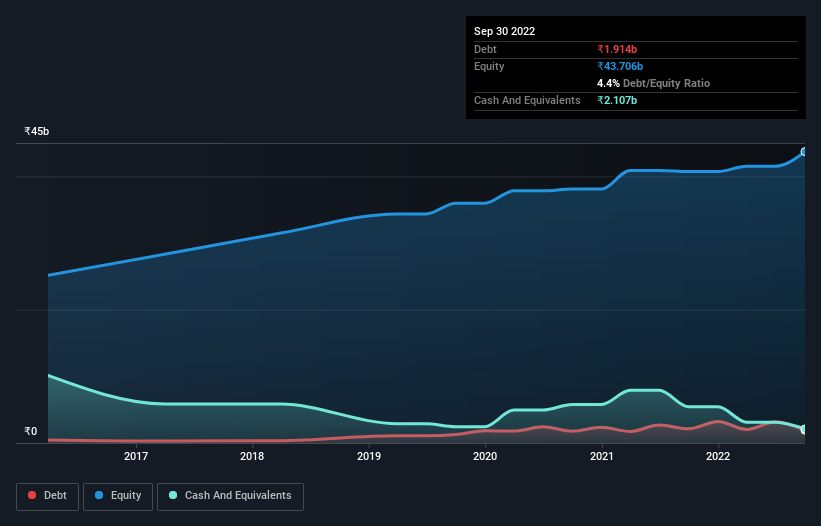Does Kansai Nerolac Paints (NSE:KANSAINER) Have A Healthy Balance Sheet?

The external fund manager backed by Berkshire Hathaway's Charlie Munger, Li Lu, makes no bones about it when he says 'The biggest investment risk is not the volatility of prices, but whether you will suffer a permanent loss of capital.' So it seems the smart money knows that debt - which is usually involved in bankruptcies - is a very important factor, when you assess how risky a company is. As with many other companies Kansai Nerolac Paints Limited (NSE:KANSAINER) makes use of debt. But is this debt a concern to shareholders?
What Risk Does Debt Bring?
Debt is a tool to help businesses grow, but if a business is incapable of paying off its lenders, then it exists at their mercy. Ultimately, if the company can't fulfill its legal obligations to repay debt, shareholders could walk away with nothing. However, a more usual (but still expensive) situation is where a company must dilute shareholders at a cheap share price simply to get debt under control. Of course, the upside of debt is that it often represents cheap capital, especially when it replaces dilution in a company with the ability to reinvest at high rates of return. When we think about a company's use of debt, we first look at cash and debt together.
View our latest analysis for Kansai Nerolac Paints
What Is Kansai Nerolac Paints's Debt?
You can click the graphic below for the historical numbers, but it shows that Kansai Nerolac Paints had ₹1.91b of debt in September 2022, down from ₹2.12b, one year before. However, its balance sheet shows it holds ₹2.11b in cash, so it actually has ₹193.2m net cash.

A Look At Kansai Nerolac Paints' Liabilities
Zooming in on the latest balance sheet data, we can see that Kansai Nerolac Paints had liabilities of ₹15.3b due within 12 months and liabilities of ₹2.35b due beyond that. On the other hand, it had cash of ₹2.11b and ₹14.5b worth of receivables due within a year. So it has liabilities totalling ₹1.02b more than its cash and near-term receivables, combined.
This state of affairs indicates that Kansai Nerolac Paints' balance sheet looks quite solid, as its total liabilities are just about equal to its liquid assets. So it's very unlikely that the ₹229.4b company is short on cash, but still worth keeping an eye on the balance sheet. Despite its noteworthy liabilities, Kansai Nerolac Paints boasts net cash, so it's fair to say it does not have a heavy debt load!
On the other hand, Kansai Nerolac Paints's EBIT dived 18%, over the last year. If that rate of decline in earnings continues, the company could find itself in a tight spot. The balance sheet is clearly the area to focus on when you are analysing debt. But it is future earnings, more than anything, that will determine Kansai Nerolac Paints's ability to maintain a healthy balance sheet going forward. So if you're focused on the future you can check out this free report showing analyst profit forecasts.
But our final consideration is also important, because a company cannot pay debt with paper profits; it needs cold hard cash. While Kansai Nerolac Paints has net cash on its balance sheet, it's still worth taking a look at its ability to convert earnings before interest and tax (EBIT) to free cash flow, to help us understand how quickly it is building (or eroding) that cash balance. In the last three years, Kansai Nerolac Paints's free cash flow amounted to 30% of its EBIT, less than we'd expect. That's not great, when it comes to paying down debt.
Summing Up
We could understand if investors are concerned about Kansai Nerolac Paints's liabilities, but we can be reassured by the fact it has has net cash of ₹193.2m. So we are not troubled with Kansai Nerolac Paints's debt use. When analysing debt levels, the balance sheet is the obvious place to start. However, not all investment risk resides within the balance sheet - far from it. We've identified 2 warning signs with Kansai Nerolac Paints , and understanding them should be part of your investment process.
Of course, if you're the type of investor who prefers buying stocks without the burden of debt, then don't hesitate to discover our exclusive list of net cash growth stocks, today.
Valuation is complex, but we're here to simplify it.
Discover if Kansai Nerolac Paints might be undervalued or overvalued with our detailed analysis, featuring fair value estimates, potential risks, dividends, insider trades, and its financial condition.
Access Free AnalysisHave feedback on this article? Concerned about the content? Get in touch with us directly. Alternatively, email editorial-team (at) simplywallst.com.
This article by Simply Wall St is general in nature. We provide commentary based on historical data and analyst forecasts only using an unbiased methodology and our articles are not intended to be financial advice. It does not constitute a recommendation to buy or sell any stock, and does not take account of your objectives, or your financial situation. We aim to bring you long-term focused analysis driven by fundamental data. Note that our analysis may not factor in the latest price-sensitive company announcements or qualitative material. Simply Wall St has no position in any stocks mentioned.
About NSEI:KANSAINER
Kansai Nerolac Paints
Manufactures and supplies paints and varnishes, enamels, and lacquers in India.
Excellent balance sheet average dividend payer.
Similar Companies
Market Insights
Community Narratives



